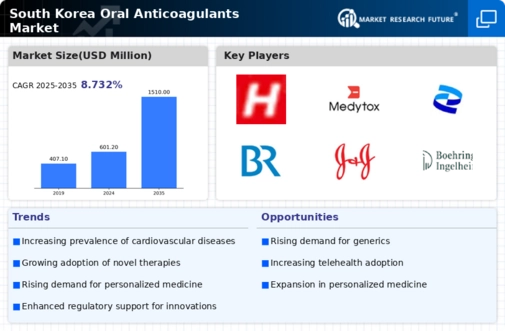Increasing Aging Population
The increasing aging population in South Korea is a pivotal driver for the oral anticoagulants market. As individuals age, the risk of developing cardiovascular diseases and thromboembolic disorders escalates. According to recent statistics, approximately 14.3% of South Korea's population is aged 65 and older, a figure projected to rise significantly in the coming years. This demographic shift is likely to lead to a higher demand for anticoagulant therapies, as older adults are more susceptible to conditions requiring anticoagulation. Consequently, pharmaceutical companies may focus on developing targeted therapies to cater to this growing segment, thereby expanding the oral anticoagulants market. Furthermore, the healthcare system may adapt to accommodate the increased need for anticoagulation management, enhancing patient access to these essential medications.
Supportive Healthcare Policies
Supportive healthcare policies in South Korea are fostering growth in the oral anticoagulants market. The government has implemented various initiatives aimed at improving access to essential medications, including anticoagulants. These policies often include subsidies and reimbursement schemes that make treatments more affordable for patients. As a result, the utilization of oral anticoagulants has increased, with a reported rise of 10% in patient access to these therapies over the past year. Furthermore, the South Korean healthcare system is increasingly prioritizing preventive care, which aligns with the use of anticoagulants for stroke prevention and management of thromboembolic disorders. This supportive environment is likely to encourage pharmaceutical companies to invest in research and development, ultimately benefiting the oral anticoagulants market.
Rising Awareness of Stroke Prevention
Rising awareness regarding stroke prevention is significantly influencing the oral anticoagulants market. Educational campaigns and healthcare initiatives in South Korea have heightened public understanding of the risks associated with atrial fibrillation and other conditions that necessitate anticoagulation therapy. As a result, more patients are seeking medical advice and treatment options to mitigate their risk of stroke. This trend is reflected in the increasing number of prescriptions for oral anticoagulants, which have seen a growth rate of approximately 8% annually. Healthcare providers are also more proactive in screening patients for conditions that require anticoagulation, further driving demand. The oral anticoagulants market is thus positioned to benefit from this heightened awareness, as patients become more informed about their treatment options and the importance of adhering to prescribed therapies.
Growing Incidence of Atrial Fibrillation
The growing incidence of atrial fibrillation (AF) in South Korea is a critical driver for the oral anticoagulants market. AF is a major risk factor for stroke, and its prevalence is on the rise due to factors such as an aging population and lifestyle changes. Recent studies indicate that approximately 1.5 million individuals in South Korea are living with AF, a number that is expected to increase as awareness and diagnosis improve. This trend is likely to lead to a higher demand for anticoagulant therapies, as patients with AF require effective management to reduce their stroke risk. Consequently, the oral anticoagulants market may experience substantial growth as healthcare providers seek to offer appropriate treatment options for this expanding patient population.
Technological Advancements in Drug Delivery
Technological advancements in drug delivery systems are poised to enhance the oral anticoagulants market. Innovations such as novel formulations and delivery mechanisms are being developed to improve the efficacy and safety profiles of anticoagulant medications. For instance, the introduction of fixed-dose combinations and user-friendly administration methods may facilitate better patient compliance. In South Korea, the market for oral anticoagulants is projected to reach approximately $1.5 billion by 2027, driven in part by these advancements. Additionally, the integration of digital health technologies, such as mobile applications for medication management, could further streamline patient adherence to anticoagulation therapy. As these technologies evolve, they may create new opportunities for pharmaceutical companies to differentiate their products in the competitive landscape of the oral anticoagulants market.

















Leave a Comment